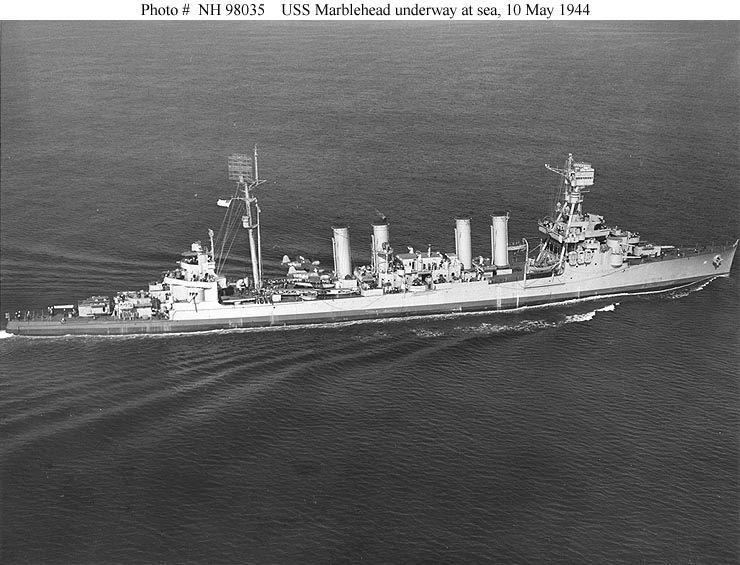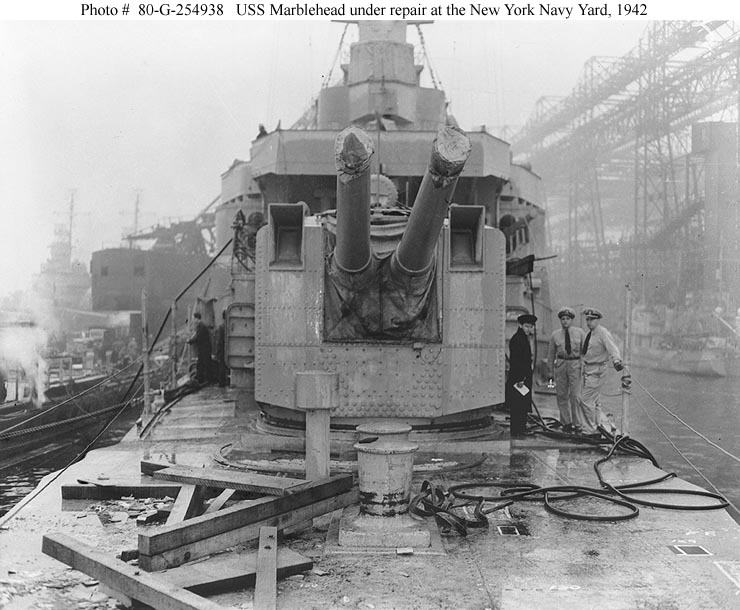skip to main |
skip to sidebar
USS Marblehead (CL-12). A beautiful girl who was part of the isolated and forgotten U.S. Asiatic Fleet at the start of WWII. After the Pacific War began in December 1941, Marblehead operated in the Netherlands East Indies as part of a greatly outnumbered Allied naval force. On 24 January 1942 she covered the Battle of Balikpapan, in which U.S. destroyers made a daring and successful attack on Japanese invasion shipping off Borneo. While steaming in the Java Sea on 4 February, en route to again attack the Japanese, Marblehead was hit and near-missed by several enemy bombs. With great difficulty the severely damaged ship was able to make port at Tjilatjap, Java, for immediate repairs, then went back to the U.S. by way of Ceylon and South Africa.
After the Pacific War began in December 1941, Marblehead operated in the Netherlands East Indies as part of a greatly outnumbered Allied naval force. On 24 January 1942 she covered the Battle of Balikpapan, in which U.S. destroyers made a daring and successful attack on Japanese invasion shipping off Borneo. While steaming in the Java Sea on 4 February, en route to again attack the Japanese, Marblehead was hit and near-missed by several enemy bombs. With great difficulty the severely damaged ship was able to make port at Tjilatjap, Java, for immediate repairs, then went back to the U.S. by way of Ceylon and South Africa.
As part of the ABDA Fleet, she had to fight her way back home ... On the 4th, the ships steamed out of Bunda Roads and headed for another Japanese convoy sighted at the southern entrance to the Makassar Straits. At 09:49, 36 enemy bombers were sighted closing in on the formation from the east.
In the ensuing battle of Makassar Strait, Marblehead successfully maneuvered through three attacks. After the third an enemy plane spiraled toward the cruiser, but her gunners splashed it. The next minute a fourth wave of seven bombers released bombs at Marblehead. Two were direct hits and a third a near miss close aboard the port bow causing severe underwater damage. Fires swept the ship as she listed to starboard and began to settle by the bow. Her rudder jammed, Marblehead, continuing to steam at full speed, circled to port her gunners kept firing, while damage control crews fought the fires and helped the wounded. By 1100 the fires were under control. Before noon the enemy planes departed, leaving the damaged cruiser with 15 dead or mortally wounded and 84 seriously injured.
... the long way.
Marblehead’s engineers soon released the rudder angle to 9° left, and at 1255 she retired to Tjilatjap, steering by working the engines at varying speeds. She made Tjilatjap with a forward draft of 30 feet, aft 22 feet. Unable to be docked there, her worst leaks were repaired and she put to sea again on the 13th, beginning a voyage of more than 9,000 miles in search of complete repairs.
Still steering with her engines, she made Trincomalee, Ceylon on the 21st. Repairs could not be made there or anywhere in India for several weeks. So Marblehead departed for South Africa 2 March. After touching at Durban and Port Elizabeth, Marblehead arrived at Simonstown 24 March. There she underwent extensive repairs and on 15 April sailed for New York. Steaming via Recife, Brazil, she arrived New York 4 May and immediately entered drydock at the navy yard.
What a grand girl.
After the Pacific War began in December 1941, Marblehead operated in the Netherlands East Indies as part of a greatly outnumbered Allied naval force. On 24 January 1942 she covered the Battle of Balikpapan, in which U.S. destroyers made a daring and successful attack on Japanese invasion shipping off Borneo. While steaming in the Java Sea on 4 February, en route to again attack the Japanese, Marblehead was hit and near-missed by several enemy bombs. With great difficulty the severely damaged ship was able to make port at Tjilatjap, Java, for immediate repairs, then went back to the U.S. by way of Ceylon and South Africa.










No comments:
Post a Comment